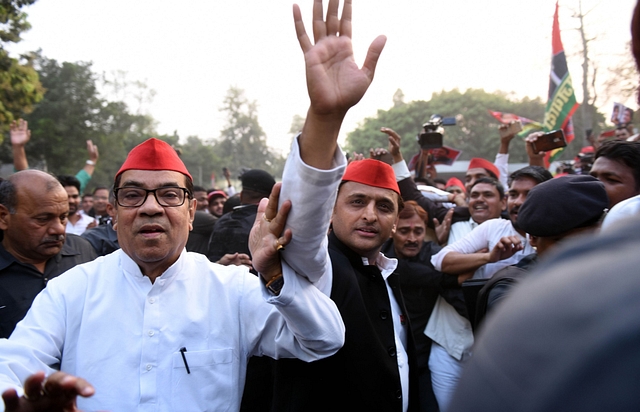
Has The Most Important Alliance For The 2019 Elections Been Sealed?
The coalition games will play out in state after state now and the recent wins of the Congress will be a decisive factor in determining what the mahagathbandhan looks like closer to the 2019 elections.
With the 2019 elections barely months away, coalition games in major states are back in full force. Though it started with the Telugu Desam Party (TDP) backing out of the National Democratic Alliance (NDA), the 2019 electoral season kicked off with Upendra Kushwaha moving out of the coalition to hedge his chances. The massively successful weather vane instincts of the Lok Janshakti Party leader Ram Vilas Paswan has also been acting up and in the days to come, there might be some movement in that direction also.
But, while more attention seems to be directed at the ruling NDA, the resurgence of the Congress in the recent state elections has led to some permutations, combinations and hedging of chances among the potential mahagathbandhan group also. And these discussions and deliberations are interesting going into the 2019 polls, particularly in the massively important state of Uttar Pradesh. The road to Delhi goes via UP and it is important to see how the results from Rajasthan and Madhya Pradesh are influencing the coalition games in the state.
Though the Bahujan Samaj Party (BSP) did not join the Congress in either Rajasthan, MP or Chhattisgarh, the BSP supremo Mayawati made it clear that they would provide support to the Congress in both Rajasthan and MP, where their support was required to reach the half way mark. This was a given for any political observer but the open endorsement can be seen as an indication of things to come in the next year.
According to a report by Dainik Jagran, the recent results have not made a dent in the coalition politics in the state and the Samajwadi Party or SP-BSP- Rashtriya Lok Dal or RLD combine has decided to contest the elections together and have excluded the Congress out of it. Out of the 80 seats in UP, the BSP will be contesting 38, the SP 37 and the RLD three seats (Baghpat, Kairana and Mathura).
While the number of seats seems to have been finalised, the final selection will be made at a later date based on an analysis of the past results and trends. But, it is important to note that the combine will not be fielding any candidates from the seats of Rae Bareli and Amethi which are the traditional seats of the Gandhi family, and from where Sonia and Rahul Gandhi have been elected multiple times.
The resurgence of the Congress has created an interesting dynamic in the state. The turn in fortunes has made the Congress a stronger party which would certainly make them negotiate for more seats as a part of any coalition. This would go against the interests of the two regional parties who would find themselves short changed and in a more politically vulnerable position. But the idea of a mahagathbandhan where every fight in every seat is made bipolar, is going to be difficult with the Congress contesting alone in UP.
There are two models which could be studied here. The first is the Gorakhpur-Phulpur model which is a BSP-SP combine with the Congress fielding a candidate. In this by-poll, the Congress managed only 2 per cent of the valid votes and the BSP-SP combine won against BJP by a margin of about 22,000 votes. Similarly in Phulpur, the Congress managed 2.6 per cent of the vote share and the BJP candidate was defeated by about 60,000 votes.
The second model is the Kairana-Noorpur model where the SP-BSP-RLD combine fielded a candidate and the Congress abstained from fielding one, necessarily positing a completely united opposition against the BJP. In this case, the RLD candidate defeated the BJP candidate by about 45,000 votes. In the Noorpur assembly constituency, the SP candidate won by a margin of 5,600 against the BJP candidate.
In both these cases, it appears that the SP-BSP combine would have a limited threat even if the Congress is kept out of the united opposition. But, the key factor not accounted for here is the change in the public mood post the results of MP, Rajasthan and Chhattisgarh. Even if a little bit of the positive sentiment works in favour of the Congress in UP, it will make a dent in the vote share of the united opposition, thus benefitting the BJP. On the other hand, at this stage the Congress does not seem to be equipped to chart a complete turnaround in the state and with less than five seats in UP, its bargaining power in the national mahagathbandhan will get weakened.
After Kairana, the BJP had been confronted with the question of the strategy through which such a united opposition in the state could be tackled. But though these are very early days, a three-way fight could work in its favour. Ultimately though, the BJP knows that irrespective of what permutation-combination works in the state, a post poll alliance between the Congress and the SP-BSP combine is the most probable outcome, if it falls short of the halfway mark. In that sense, the BJP will have the disadvantage coming into the election.
The coalition games will play out in state after state now and the recent wins of the Congress will be a decisive factor in determining what the mahagathbandhan looks like closer to the 2019 elections.